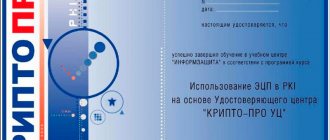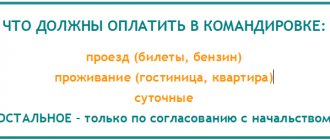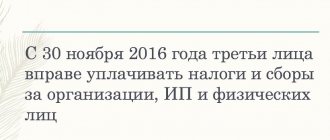How to make a calculation
The procedure for calculating the tax of the simplified tax system “Income” is regulated by Art. 346.21 Tax Code of the Russian Federation. To do this, you will need a tax rate (in this case - 6%; for some regions it can be reduced) and a tax base.
| 1 | Sum up the income received in fact for each quarter (with a cumulative total) |
| 2 | Determine size:
|
| 3 | Determine the tax base (TB): TB = Income – Contributions |
| 4 | Calculate the advance payment paid at the end of the reporting period (quarter/half-year/9 months). The formula is: AP = NB – Contributions – AVpr АВр – advance payments of tax for previous reporting periods of the year. |
| 5 | Final calculation of the simplified tax system 6%: TAX = NB × 6% – АВр |
Remember that the calculated tax is reduced by the amount of insurance premiums made in the reporting period (+ paid sick leave). For individual entrepreneurs without employees it is 100%, and for legal entities and businessmen hiring staff up to 50%.
Consider both tax and contributions as cumulative total.
How to calculate simplified tax system 6 percent: general formula
First of all, let's study how to calculate the simplified tax system of 6 percent.
Tax under the simplified tax system “income” is calculated according to the formula:
USN = NB × St − USNav − Vych,
Where:
NB is the tax base, which is defined as the total amount of all income, including non-operating income, named in Art. 249 and 250 of the Tax Code of the Russian Federation.
How to calculate income using a simplified method? Their size under the simplified tax system in all cases is taken into account in cash (Article 273 of the Tax Code of the Russian Federation), i.e. on the date of receipt of funds at the cash desk or into a bank account, and is displayed in the book of income and expenses (KUDiR). Income is determined on a cumulative basis from one reporting period to another, and then over the tax period - a year.
St - rate. In general, the simplified tax rate for “income” is 6%. But regional legislators have the right to establish differentiated tax rates from 1 to 6% for certain groups of taxpayers.
For example, clause 2.3 of Art. 1 of the Law of the Ivanovo Region “On the simplified tax system” dated December 20, 2010 No. 146-OZ, a preferential tax rate of 4% is established for certain categories of taxpayers. However, it is applicable only if the income from the implementation of a preferential type of activity amounted to more than 70% of the total amount of all income received. If the share of income from preferential activities is less than 70%, then the taxpayer is obliged to apply the federal rate of 6%.
STS - advance payments under the simplified tax system transferred to the budget based on the results of the reporting periods: 1st quarter, half a year and 9 months. Advances are calculated using a formula similar to the annual tax calculation.
Vych - the amount of deductions.
Let's consider what amounts are included in deductions, as well as how to calculate the simplified tax system on income.
Calculation example
LLC "Guru" is in a simplified tax regime with the object "Income" and has employees. It is necessary to determine the amount of advance tax payments deducted in the reporting periods of 2020.
Actual income, insurance contributions and benefits made, as well as all final calculations are presented below in the table (the amounts of income and contributions/benefits are taken arbitrarily as an example).
The Guru Society reached the end of 2020 with the following indicators:
Individual entrepreneurs who work without hiring labor pay pension and health insurance contributions only for themselves.
The table below shows an example of calculating the simplified tax system “Income” in 2019:
If you find an error, please select a piece of text and press Ctrl+Enter.
Insurance premiums for calculating tax on the simplified tax system
Insurance premiums are not a feature of the simplified tax system (they are paid in all regimes), but without understanding what these payments are, it will be difficult to understand further calculations.
Contributions are transfers that are received for insurance of individuals: pension, medical, social, against injuries and occupational diseases. Individual entrepreneurs pay contributions for themselves, and employers pay contributions for their employees. Tariffs and specific amounts of contributions are established by the Tax Code of the Russian Federation
- The mandatory amount of individual entrepreneur contributions for himself in 2020 is 36,238 rubles plus 1% of the amount of annual income over 300,000 rubles (if received). Mandatory contributions must be paid by the end of the current year, and the additional contribution must be paid by July 1 of the year following the reporting year.
- Standard premium rates for employers range from 30.2% to 38.5% of employee benefits in total. However, some categories of employers, for example, IT companies, pay reduced rates. Employee contributions are paid every month.
The right to reduce the tax on the simplified tax system by the amount of contributions paid by employers or individual entrepreneurs for themselves is provided for in Article 346.21 of the Tax Code of the Russian Federation. Thanks to this norm, simplifiers pay to the budget even less than 6% of the income received.
Calculation of the simplified tax system: income
In KUDiR, a simplified person reflects his income from sales and non-operating income (clause 1 of Article 346.15 of the Tax Code of the Russian Federation) using the “cash” method.
What relates to income from sales can be read in Art. 249 of the Tax Code of the Russian Federation. The list of non-operating income is given in Art. 250 Tax Code of the Russian Federation. The sum of income from sales and non-operating income of a simplifier is its tax base, on the basis of which the tax is calculated.
The “cash” method of recognizing the income of a simplifier means that his income is recognized on the date of receipt of funds and other property or repayment of debt in another way (clause 1 of Article 346.17 of the Tax Code of the Russian Federation).
How to reduce tax under the simplified tax system “income”
Unlike the simplified tax system of 15% (“income minus expenses”), in the “income” simplified tax system expenses do not reduce the income of the simplified tax system, i.e. they are not taken into account in its tax base. However, you can reduce the tax already calculated based on the income of the simplifier for the following expenses incurred in this reporting period (clause 3.1 of Article 346.21 of the Tax Code of the Russian Federation):
- insurance premiums paid from employee benefits;
- temporary disability benefits paid at the expense of the employer (except for industrial accidents and occupational diseases);
- payments for voluntary insurance of employees in case of their temporary disability under certain conditions.
It is important to keep in mind that the above payments can reduce tax by a maximum of 50%.
If the simplifier is an individual entrepreneur and has no employees, then he can reduce the tax by paid insurance premiums in a fixed amount without restrictions.
When calculating the tax at the end of each quarter, the simplifier takes into account those advance payments that he has already paid this year (clause 5 of Article 346.21 of the Tax Code of the Russian Federation).
Payments for insurance
Despite the fact that, according to the Tax Code of the Russian Federation, the tax period for calculating tax on the simplified tax system is a calendar year, the obligation to pay this tax arises quarterly. The calculation is carried out on a cumulative basis: 1st quarter, half-year, nine months of the calendar year, calendar year.
Deadlines for payment of advance payments for single tax:
- based on the results of the first quarter - April 25;
- based on the results of the half year - July 25;
- based on the results of nine months - October 25;
- at the end of the year - until March 31 for organizations; until 30.04 for individual entrepreneurs. When calculating the simplified tax system at the end of the year, advance payments paid are taken into account.
The calculation of the advance payment based on the results of the half-year is similar to the calculations for the 1st quarter. Then you need to multiply the tax base obtained based on the results of 6 months (from January to June inclusive) by the tax rate, and from this amount subtract the advance payment already paid for the first quarter. In the case of the simplified tax system “income”, the amount received must be reduced by insurance premiums (but not more than 50%). The resulting balance will be an advance payment for the six months.
We do the same when calculating the advance payment of the simplified tax system “income minus expenses”, except for reducing the advance payment due to insurance premiums.
At the end of the year, the single tax is calculated as follows:
- We multiply the tax base for the entire year by the tax rate. From the resulting amount we subtract all three advance payments. The resulting difference is the annual simplified tax system.
If the single tax is not remitted at the end of the year, then in addition to the penalty, a fine of 20% of the unpaid tax amount will be imposed. There is no penalty for late payment of advance payments.
The article has been edited in accordance with current legislation 10/13/2019
Calculation of the simplified tax system for income minus expenses (with examples)
Each business representative, choosing a tax regime at the beginning of his entrepreneurial journey, or changing it in the process of work, focuses primarily on the expected amount of tax payments. The main interest is to save as much as possible on taxes, but not least of all is the simplicity and clarity of the tax system. That is why the simplified taxation system is in great demand among Russian businessmen - it is quite understandable even for a non-specialist. Despite the fact that it has some subtleties and nuances, most businessmen choose it as the main mode. In this article we will talk about how to calculate tax income minus expenses using a simplified taxation system.
Calculation of simplified tax for individual entrepreneurs without employees
The calculation of the simplified tax system for an individual entrepreneur who works independently has its own characteristics. In this case, the accrued tax can be reduced by the entire amount of insurance premiums paid for yourself. And in practice, it often turns out that with small incomes of individual entrepreneurs without employees, the single tax will be equal to zero or close to it.
But for LLCs and entrepreneurs with employees, the situation is different. They also have the right to take into account insurance premiums in the calculation (for employees and individual entrepreneurs for themselves). However, they can reduce the calculated advance payments and annual tax by no more than 50%.
If we imagine that the individual entrepreneur from the example above had employees, then for the income received he had to pay at least 43,080/2 = 21,540 rubles in tax payments. Moreover, an individual entrepreneur is deprived of the opportunity to reduce tax without a limit of 50%, even if he had employees for several months or days, and not for a full year.
What is the simplified tax system for income minus expenses 15%
To begin with, let us remind you that the “simplified tax” allows you to choose one of two objects of taxation: 6% of income or income minus expenses of 15%. Depending on the size of profit and development prospects, each entrepreneur individually chooses the most suitable scheme for tax charges and payments.
Under the simplified tax system, income minus expenses, tax is calculated and paid from the amount that is the difference between income and expenses. Moreover, not all expenses are taken into account, but only those that are noted in the Tax Code of the Russian Federation, therefore it is necessary to keep strict records of these expenses, documenting and economically justifying them.
The example of many Russian entrepreneurs shows that a simplified taxation system with an income minus expenses object of 15% is beneficial if the costs of revenue are more than 60%. Therefore, it is often chosen by novice entrepreneurs or those who seriously plan to develop their business.
Minimum tax
The efficiency of labor activity may be unsatisfactory, that is, at any moment the company can work at zero or in minus. This does not mean that the amount of single tax can also be zero. Article No. 346 of the set of tax laws states that “simplifiers” who use the object “income minus” expenses are required to pay a minimum tax - income multiplied by one percent. If the amount of duty payable is less than the minimum tax, it is the minimum tax that is paid. This difference can later be included in the list of expenses or the composition of the loss, if any. When paying the minimum tax, the payer has the right to reduce its amount by “prepayment” - advance payments already paid in the current period.
Video - Calculation of the minimum tax
https://youtu.be/3KUKSazBFaE
Tax rate according to the simplified tax system: object income minus expenses
The Tax Code of the Russian Federation considers the main rate to be 15%. However, depending on the region of Russia, this rate may change downward by up to 5%. Moreover, it is assumed that starting from 2017, local authorities will be able to reduce it even to 3%, which is good news. Regions have the right to lower the rate not only based on some of their own characteristics, but also to attract interesting profitable investments. Individual regional tax rates may be revised once a year.
Attention! According to the law, aspiring entrepreneurs working in the production, scientific or social fields have the right to a zero tax rate for a two-year period, but only if the regional authorities have the will to do so. There is no need to pay even the minimum tax level.
Important! In order to find out the most effective and profitable tax rate in a particular region of the Russian Federation, you need to contact the nearest tax office.
Calculating income tax - the essence of an accounting operation for dummies
Income tax is one of the key sources for financing the state budget. Refers to federal taxes and is regulated by relevant legislation.
Income tax is paid to the state budget on income that has been reduced by the amount of expenses, that is, according to the following formula:
- UD – PNO + SHE – IT = TNP UR – PNO + SHE – IT = TNU
These abbreviations are deciphered as follows:
- UD – conditional amount of income;
- UR – company expenses;
- PNO – permanent tax liability;
- OTA – deferred tax assets;
- ONO – deferred tax liabilities;
- TNP – current profit tax;
- TNU – current tax loss.
Taxable income includes those that the company receives along with the sale of goods or services, works of its own production and purchased from other persons. The exceptions are: positive exchange rate or amount differences, penalties or fines, property received free of charge, interest on loans:
All companies pay a percentage of their profits to the budget, with the exception of those that operate under special taxes: Unified Agricultural Tax (Unified Agricultural Tax), UTII (Unified Tax on Imputed Income), STS (simplified system).
Tax payers are all domestic companies on the common system and foreign ones that earn profits in the state or operate through state representative offices. Individual entrepreneurs, as well as companies involved in the preparation of significant events (Olympiads, world football championship, etc.) also do not pay:
According to the latest current data, the general income tax rate is 20%, of which 3%, according to the updated legislation, goes to the general budget, and 17% to the regional budget. The minimum tax rate of 13.5% in the federal budget can only be applicable to those enterprises that employ people with disabilities, produce cars, operate in special economic zones and act as residents of industrial parks and technopolises.
Financial indicators for calculating tax income minus expenses
In order to correctly and reliably calculate the simplified tax system with the object of taxation “income minus expenses”, you must keep in mind the following data:
- tax base for the billing period;
- advance payment attributable to the tax base;
- advance payment at the end of the reporting period.
It should be remembered that the tax base must be calculated based on the results of the following reporting periods: one quarter, 6 months and 9 months.
Let's give an example
In the example under consideration, we will take as the subject of taxation. We take 2020 as the period being calculated. The company's monthly income is shown below. We need to calculate the amount of advance payments and the amount of tax payable for each reporting period: the first quarter, half a year and nine months. At the same time, we mean that there are no unbearable losses.
So, let’s assume that for 2020 the organization received the following income minus expenses:
January - 20 thousand rubles. February - 30 thousand rubles. March - 40 thousand rubles. April - 60 thousand rubles. May - 70 thousand rubles. June - 80 thousand rubles. July - 90 thousand rubles. August - 100 thousand rubles. September - 110 thousand rubles. October - 120 thousand rubles. November - 130 thousand rubles. December - 140 thousand rubles.
Based on these data, we consider the tax base, as expected, as a cumulative total. Simple calculations give the following result:
First quarter - 90 thousand rubles; Six months - 300 thousand rubles; Nine months - 600 thousand rubles; Year - 990 thousand rubles.
The next stage: we calculate the amount of the advance payment for six months. To do this, we calculate the tax base from the beginning of the year to its half on an accrual basis and again multiply by the tax rate:
300 thousand rubles. * 15% = 45 thousand rubles
It should be remembered that this amount can be reduced by the advance payment paid to the budget for the first quarter. That is:
Let's move on to calculating the advance payment for three quarters. Again, we add up the income for nine months and multiply by the tax rate. We get:
600 thousand rubles. * 15% = 90 thousand rubles.
Do not forget that this result must be reduced by advance payments already paid for the first quarter and six months. As a result, payment for nine months, the advance payment will be:
Well, the final calculation is the amount to be paid based on the annual results. We calculate it all according to the same scheme:
Attention! In some cases, the amount of tax at the end of the tax period with “simplified” income minus expenses may be less or more than the amount of accrued advance payments. It should be remembered that if it is higher, then this tax must be paid extra to the treasury. It also happens that at the end of the year a tax overpayment is discovered. There are two ways to solve this problem: the tax is either offset against future payments or returned to the taxpayer's accounts.
Calculation methods
Let’s assume that the organization has the following indicators at the end of the first quarter of 2020:
- income from sales – 1,500,000 rubles;
- expenses that reduce income from sales - 950,000 rubles;
- non-operating income – 15,000 rubles;
- non-operating expenses - 35,000 rubles;
The intermediate tax base will be 530,000 rubles. (1,500,000 rub. 15,000 rub. – 950,000 rub. – 35,000 rub.).
The final tax base will be 530,000 rubles. (530,000 rub. – 0 rub.).
The amount of income tax will be 106,000 rubles. (RUB 530,000 x 20%).
A novice accountant often needs step-by-step and clear instructions for correctly calculating taxes in accordance with the legislation of the Russian Federation. All basic terms, concepts, rules are regulated by the Tax Code of the Russian Federation. One of the most difficult to calculate is income tax. It requires a serious and careful approach, careful study. It is paid by most large organizations in our country.
Formulas for calculation
Based on the above, let's try to calculate using an example. A legal entity applying the general taxation system received income for the year from its activities in the amount of 5,000,000 rubles. Expenses incurred in the specified period amounted to 2,800,000 rubles. All expenses are confirmed by primary documentation.
We calculate the tax transferred to the Regional budget.
NP = (5,000,000 - 2,800,000)* 18/100 = 396,000 rubles.
We calculate taxes transferred to the Federal Budget.
NP = (5,000,000 - 2,800,000)* 2/100 = 44,000 rubles.
The total amount that the organization needs to pay is 440 thousand rubles. However, when paying tax at the end of the year, it is necessary to reduce the calculated amount by the amount of advance payments made by the organization in the reporting period.
After reading this article, it will become much easier for accountants at an enterprise to correctly perform the required calculations.
The third important element that is needed to understand how income taxes are calculated is the tax period. For income tax it is one year. However, if all enterprises begin to pay this tax once a year, then budget revenues will be uneven. Therefore, advance payments have been introduced, which can be of three types (Article 286 of the Tax Code of the Russian Federation):
- Quarterly. Their amount is determined on the basis of calculations for a quarter, 6 or 9 months, minus the tax paid for the previous period. These payments are made by all organizations, except for budgetary cultural institutions and companies that voluntarily switched to monthly payments based on actual profits (clause 3 of Article 286 of the Tax Code of the Russian Federation).
- Quarterly, broken down by month. The organization is obliged to switch to them if the revenue for each of the 4 previous quarters amounted to more than 15 million rubles. A number of categories of companies listed in paragraph 3 of Art. 286 of the Tax Code of the Russian Federation (in particular, budgetary and non-profit organizations) are exempt from monthly advances.
The amount of the monthly payment within each quarter is determined based on the tax calculated for the previous quarter or quarters on an accrual basis from the beginning of the year. Based on the results of the current quarter, the amount is adjusted based on the actual quarterly profit.
- Monthly payments based on the actual profit received for the month. Any organization can voluntarily switch to this option. In this case, the tax is calculated every month on an accrual basis from the beginning of the year and is paid taking into account the amounts transferred for previous months.
Let's look at an example of how to calculate income tax when paying advances with a monthly breakdown.
The company made a profit of 30 million rubles for the 1st quarter of 2020. and paid tax at a rate of 20% in the amount of 6 million rubles. Profit for the first half of the year - 80 million rubles.
Av = 6 million rubles. / 3 = 2 million rubles.
Thus, in just six months, 12 million rubles were paid to the budget. (6 million rubles for the 1st quarter and 6 million rubles — advances for the 2nd quarter).
NP = 80 million rubles. x 20% = 16 million rubles.
This means that at the end of the six months we still need to pay an additional 4 million rubles to the budget. (16 million rubles - 12 million rubles).
If you find an error, please highlight a piece of text and press Ctrl Enter.
The provisions on the income tax that commercial enterprises are required to calculate, the tax base, and other indicators used in the calculation are announced by the legislator in the Tax Code.
It says that:
- Taxpayers are organizations that receive income from their financial assets on the territory of the Russian Federation:
- The following organizations cannot be taxpayers: foreign organizations that, at the time of the Olympic Games, are involved in their organization and broadcasting from the site;
- Russian ones that received research status within the Skolkovo project.
- for the previous calendar year had an income of within 10 million rubles;
cannot have a profit (non-profit) or have no income, but are required to submit a report.
The final amount of the NP minus advance payments is paid annually by March 28. Advance payments (monthly or quarterly) are paid by the 28th day of the month following the reporting period.
The period for calculating the tax base is a calendar year.
| 3 months of the year | 01.01–31.03 |
| 6 months of the year | 01.01–30.06 |
| 9 months of the year | 01.01–30.09 |
| 12 months of the year | 01.01–31.12 |
If the enterprise has the right to choose 1 month as the reporting period, then the calculation will be carried out monthly for each elapsed month. To calculate the size of the NP, it is necessary to multiply the tax rate by the tax base. The company chooses the rate in accordance with current legislation, and calculates the tax base independently using its own software or using an online calculator.
| Calculate profit (loss) from the main (sales) activity (PoP) | It will be equal to the amount of income (DotR) reduced by expenses (RotR) that the enterprise incurred as a result of the main HD: PotR = DotR - RotR. |
| Calculate profit (loss) from non-operating operations (PotVRO) | To do this, you need to subtract expenses (RotVRO) from the corresponding income (DotVRO): PotVRO = DotVRO - RotVRO. |
| Final tax base amount (NB) | It will turn out when the two received profit values are added up (PotR and PotVRO) and the losses that are subject to transfer or losses transferred (LP) are subtracted from the result: NB = PotR PotVRO - LP. |
The calculation of NP can be considered using an example. Thus, the enterprise’s revenue (Additional Development) for the 1st quarter amounted to 1.8 million rubles, including VAT of 300 thousand rubles.
| Product manufacturing | 600 thousand rubles. |
| Salary | 400 thousand rubles. |
| Depreciation | 60 thousand rubles. |
| Insurance premiums | 80 thousand rubles. |
| Adjustment of last year's tax loss (TL) | 110 thousand rubles. |
During this period there were no non-operating income and expenses.
| Federal | 5 thousand rubles. = 250 thousand rubles. x 2% |
| Local | 45 thousand rubles. = 250 thousand rubles. x 18% |
1,000,000 rub. – 800,000 rub. = 200,000 rub.
200,000 rub. × 20% = 40,000 rub.
At first glance, judging by the example of calculating income tax, there is nothing complicated here. However, in practice everything is not so easy. Income tax has many nuances, without knowing about which you can make a mistake and break the law. Therefore, you should start calculating only after thoroughly studying the current procedure.
The calculation of corporate income tax is strictly regulated by Chapter. 25 Tax Code of the Russian Federation. Under no circumstances should you deviate from the rules set out in the code, because this is fraught with claims from tax authorities, additional tax assessments, penalties, and possibly even a fine. That is why it is important for tax specialists of OSNO companies to know and correctly apply “profitable” rules in practice.
But it is not so easy to calculate the income tax of an organization, strictly following the law, and at the same time not to infringe on the economic interests of the legal entity. This section of the site will help you with this.






